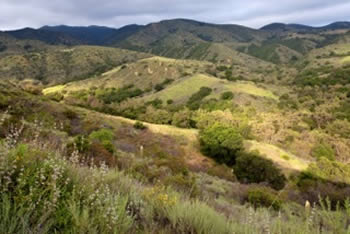State and federal dollars fall behind NCCP/HCP commitments
Both at the state and federal levels, contractual obligations to our regional habitat plans will not be met if current funding trends continue.

State of California Natural Community Conservation Plans (NCCPs) and federal Habitat Conservation Plans (HCPs) are vehicles whereby economic-environmental conflicts are resolved and land is conserved on an ecosystem basis. The San Diego Multiple Species Conservation Program (MSCP) and Riverside Multiple Species Habitat Conservation Plan (MSHCP) both contain contractual obligations for fair shares of land acquisition from the state and federal governments. Similarly, the local government sponsors have financial commitments. There are also many other NCCPs around the state with federal and state commitments. If totaled statewide, the state and federal unmet commitment is over $1.6 billion. It is important to note that all state, local, and federal contributions are above and beyond project mitigation, and allow the plans to actually recover species.
To date, all the sources are roughly on track, but as state bond funds become depleted and federal outlays shrink, major shortfalls can now be forecast. Indeed, the environmental success of the plans – as well as the well documented economic benefits for infrastructure and development – are at risk.
At the state level, the recently voter-passed Water Bond failed to replenish dollars that can help assemble NCCPs/HCPs. Unlike previous Water Bonds, and in spite of a major effort by EHL and others, NCCPs/HCPs were not allocated watershed protection funds. It sometimes seems like the Administration and Legislature have forgotten about their commitments to the State’s premier biodiversity program. In addition, the conservation community in Sacramento has shifted its emphasis to other projects and is not providing past levels of support. An upcoming Park Bond is an opportunity, but the initial draft provides minimal assistance.
However, a new state source has emerged in the form of Cap and Trade revenues, which are proceeds from California’s greenhouse gas (GHG) emissions reduction program. Natural lands are, appropriately, a designated target for carbon sequestration investments, but the first round of investment allocations offered little to Southern California landscapes. EHL has provided detailed input to the State on the second investment round so that our habitat lands get a fair shake. Indeed, recent scientific information shows that our scrub and savannah habitats are important resources for carbon sequestration, particularly in the soil, and competitive with wetlands and forests. In addition, Cap and Trade dollars are being used to prevent conversion of agricultural lands to GHG-intensive urban uses. Habitat protection accomplishes the same goal.
At the federal level, over the last decade there has been a precipitous decline in funds implementing the Endangered Species Act (called “Section 6" funds) and a similar drop in spending from the Land and Water Conservation Fund (LWCF), the main source of federal conservation dollars. These declines are despite escalating needs nationwide. The current Administration has failed to sufficiently prioritize its own HCPs, and a Congress that is often hostile to the environment has not improved upon the Administration’s low budget requests. However, Senators Boxer and Feinstein have done all they can, and Representative Ken Calvert of Riverside has been a shining light in preventing additional decreases. Along with Senator Feinstein, he passed a bill that makes our plans eligible for federal loans related to infrastructure. But ominously, and making a grim situation worse, Congress allowed the vital LWCF to actually expire this year. EHL travels to Washington, DC annually, and we have our work cut out for us.
While our state and federal partners have no game plan to meet their commitments, local governments have been creative and successful in raising their share of acquisition funds. Admirably, San Diego County generously uses its own General Fund to help assemble the MSCP. The City and County of San Diego have ordinances spelling out requirements for development project mitigation, and Riverside and Orange Counties have fee-based mitigation systems that generate local acquisition dollars. Also, Riverside, Orange, and San Diego voters have all put in place transportation sale taxes that generate substantial mitigation monies that help assemble the plans. Additional such sales tax measures are under consideration in San Diego and Los Angeles Counties. EHL is engaged in both efforts. Finally, Los Angeles County may put a park measure on the ballot which could help protect its Significant Ecological Areas.
In conclusion, we remain deeply concerned that plans across the state are in jeopardy due to declining state and federal dollars. Along with the California Habitat Conservation Planning Coalition, which represents NCCPs and HCPs around the state, EHL is seeking remedies.


